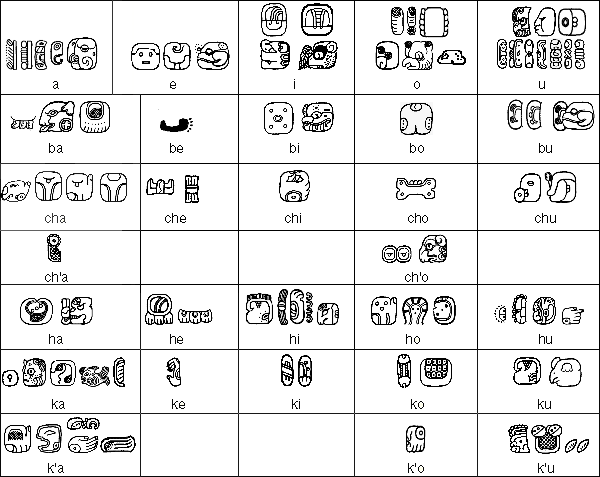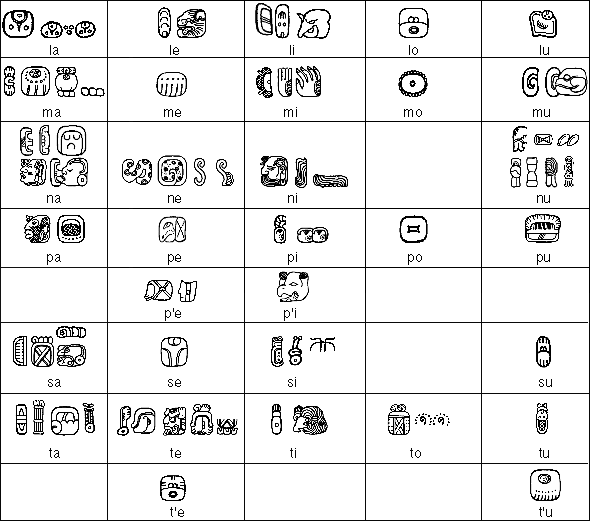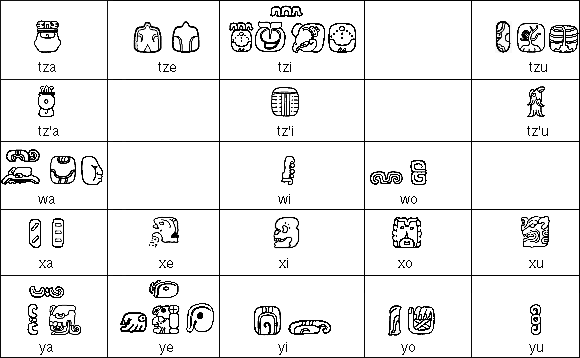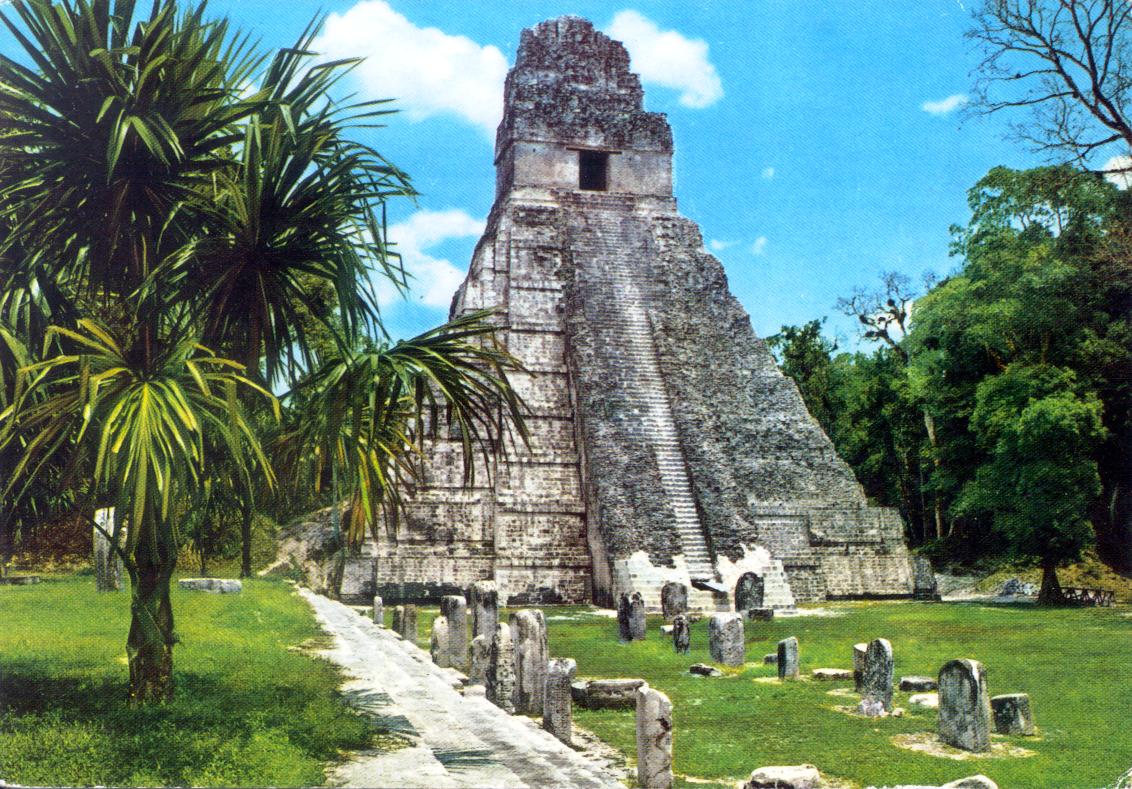Map of Where Different Mayan Languages are Spoken Today
Wednesday, June 2, 2010
Saturday, May 8, 2010
Mayan Poetry
Poetry by Humberto Ak'abal, a Guatemalan poet who wrote the following poem in Mayan in the 1950's:
El cielo
The sky
I went to the moon
And slept there.
Ri Kaj
We kateq’an puwi’jum ri’j k’isis
we katopan pa ri utza’m ri uq’ab
kawilo chi ri uwächulew
man naj tl k’o wi che ri kaj.
Pa chuwitz’ap
katkuwinik kachapo.
we katopan pa ri utza’m ri uq’ab
kawilo chi ri uwächulew
man naj tl k’o wi che ri kaj.
Pa chuwitz’ap
katkuwinik kachapo.
Yaj, xyajik
Ri ik’ are ri jun nimalaj ja
t’uyul puwi’ri uworachak ri juyub’
Ri ik’ are ri jun nimalaj ja
t’uyul puwi’ri uworachak ri juyub’
Are chi’ru nutat kinnuyajo
Ri we in kin’e pa ri ik’
Chila kinwar wi.
Ri we in kin’e pa ri ik’
Chila kinwar wi.
El cielo
Si te encaramás a un Viejo ciprés
y trepás por sus ramas,
verás que la tierra
no está lejos del cielo.
En Momostenango
podrás tocarlo.
y trepás por sus ramas,
verás que la tierra
no está lejos del cielo.
En Momostenango
podrás tocarlo.
Regaňo
La luna era una casa grande
sentada sobre el espinazo del cerro.
La luna era una casa grande
sentada sobre el espinazo del cerro.
Cuando mi papá me reganaba,
yo me iba para la luna
Y alli dormía.
yo me iba para la luna
Y alli dormía.
If you rise to the top of the old cypress
and climb onto its branches
you will see the Earth
It’s not so far from the sky.
In Momostenango
you can touch it.
and climb onto its branches
you will see the Earth
It’s not so far from the sky.
In Momostenango
you can touch it.
Scolding
The moon was a big house
sitting on the spine of the hill.
When my father scolded meThe moon was a big house
sitting on the spine of the hill.
I went to the moon
And slept there.
Friday, April 30, 2010
Ancient Mayan Script
Today, all Maya languages use the Roman Alphabet. In history, Maya used an intricate set of hieroglyphics to record their words and stories, according to Omniglot. At first, people didn't believe the Maya hieroglyphic script was a complete writing system and the symbols weren't dechipered until the 1950's by a Russian enthologist named Yuri Valentinovoch Knorosov. He was the first to suggest that Mayan hieroglyphics were in fact a complex family of phonetic sounds.
As you can see, pictures represent phonetic sounds rather than letters:
As you can see, pictures represent phonetic sounds rather than letters:
Pictures from: Omniglot
Mayan Language Perservation
Because Maya is seen as having important cultural significance in modern day Latin America, many native speakers of Maya are stepping out to take measures to preserve their language. Indigenous movements have been sparking up all over Latin America and the Maya Movement in Guatemala is one of many. The Maya Movement is working toward linguistic consciousness among Guatemalans in order to revitalize use of the language in the public sector. Spanish is the most publicly spoken and supported language in the country and is the language taught in schools. An article in the Latin American Studies Association, Fidel Guevarra states:
Full Article: Mayan Language and the Mayan Movement in Guatemala
"Rather, the linguistic complexity of the country has been considered by Ladinos to be an obstacle for development. The language used in the education system is Spanish and until recently, Mayan languages were used in schools only for the purpose of assimilating Mayas into the dominant culture by forcing them to learn Spanish."The Maya Movement is trying to fight this assimilation that has the capacity to kill both their language and their culture. By supporting bilingual education, indigenous Mayans can teach their children about their language in a public and state-supported setting. Preservation of language inherently supports preservation of culture.
Full Article: Mayan Language and the Mayan Movement in Guatemala
Maya Morphology and Phonetics
he majority of Maya sub families use a VOS fixed word order, but some branches of Maya also allow for VSO. Maya language is also considered agglutinating.
In Tzotzil Maya, a subfamily of the language found primarily in Chiapas, a compound use of prefixes and suffixes make words long and complex. Summer Institute of Linguistics gives an example:
Maya languages also have numerical classifiers in which certain shaped objects will have a different numerical classifier (such as flat objects versus round objects).
Tense in Maya is fairly simple as most Mayan languages use only two tenses (present/past or future/non-future). Aspect seems to be much more important in Mayan languages as there have been seven identified aspects: incompletive, progressive, completive/punctual, imperative, potential/future, optative, and perfective.
Any interesting fact about Yucatec Maya is its indigenous sign language found to be used in at least one Yucatan community.
Here are some examples of Yucatec Maya words and their translation in Spanish and English:
In Tzotzil Maya, a subfamily of the language found primarily in Chiapas, a compound use of prefixes and suffixes make words long and complex. Summer Institute of Linguistics gives an example:
For example, ‘the teacher’ in Tzotzil is  li jchanubtasvaneje; this expression consists of the following pieces: li ‘the’, j ‘human agent’, chan ‘learn’, ub ‘become’, tas ‘causative’, van ‘habitually’, ej ‘nominalizer’ and e ‘end of phrase’. So, the meaning of this word is literally ‘one who habitually causes (someone) to learn something’.
li jchanubtasvaneje; this expression consists of the following pieces: li ‘the’, j ‘human agent’, chan ‘learn’, ub ‘become’, tas ‘causative’, van ‘habitually’, ej ‘nominalizer’ and e ‘end of phrase’. So, the meaning of this word is literally ‘one who habitually causes (someone) to learn something’.
Another interesting aspect of Maya phonetics is the use of glottalized constants indicated by an apostrophe after the constant. li jchanubtasvaneje; this expression consists of the following pieces: li ‘the’, j ‘human agent’, chan ‘learn’, ub ‘become’, tas ‘causative’, van ‘habitually’, ej ‘nominalizer’ and e ‘end of phrase’. So, the meaning of this word is literally ‘one who habitually causes (someone) to learn something’.
li jchanubtasvaneje; this expression consists of the following pieces: li ‘the’, j ‘human agent’, chan ‘learn’, ub ‘become’, tas ‘causative’, van ‘habitually’, ej ‘nominalizer’ and e ‘end of phrase’. So, the meaning of this word is literally ‘one who habitually causes (someone) to learn something’. For example, there are three glottalized consonants in the Tzeltal phrase  c'ux c'ajc'al, which means ‘it’s hot out’, or literally, ‘the sun/day hurts’.
c'ux c'ajc'al, which means ‘it’s hot out’, or literally, ‘the sun/day hurts’.
Maya language does not have voiced and voiceless stops like in English, but instead have plain an ejective (glottalized) stops which are spoken with a vocal pop of the voice. c'ux c'ajc'al, which means ‘it’s hot out’, or literally, ‘the sun/day hurts’.
c'ux c'ajc'al, which means ‘it’s hot out’, or literally, ‘the sun/day hurts’. Maya languages also have numerical classifiers in which certain shaped objects will have a different numerical classifier (such as flat objects versus round objects).
Tense in Maya is fairly simple as most Mayan languages use only two tenses (present/past or future/non-future). Aspect seems to be much more important in Mayan languages as there have been seven identified aspects: incompletive, progressive, completive/punctual, imperative, potential/future, optative, and perfective.
For example, "kinach'ayo "You are hitting me"" can be broken down into:
k-tense/present; in-1st person DO; a-2nd person agent; ch'ay-to hit; o-incompletive.
Any interesting fact about Yucatec Maya is its indigenous sign language found to be used in at least one Yucatan community.
Here are some examples of Yucatec Maya words and their translation in Spanish and English:
| English (Español) | Yucatec Maya | |||||||||||
| One (Uno) | Hun | |||||||||||
| Two (Dos) | Ka'a | |||||||||||
| Three (Tres) | Óox | |||||||||||
| Four (Quatro) | Kan | |||||||||||
| Five (Cinco) | Ho | |||||||||||
| Man (Hombre) | Xiib | |||||||||||
| Woman (Mujer) | Ch'up | |||||||||||
| Dog (Perro) | Peek' | |||||||||||
| Sun (Sol) | K'iin | |||||||||||
| Moon (Luna) | Uh | |||||||||||
| Water (Agua) | Ha' | |||||||||||
| White (Blanco) | Sak | |||||||||||
| Yellow (Amarillo) | K'an | |||||||||||
| Red (Rojo) | Chak | |||||||||||
| Black (Negro) | Boox | |||||||||||
| Eat (Comer) | Hanal | |||||||||||
| See (Ver) | Il | |||||||||||
| Hear (Oír) | U'uy | |||||||||||
| Sing (Cantar) | K'aay | |||||||||||
About Maya Culture and History
Yucatan Mayan is a native language still used in modern day Mexico and Belize. According to Ethnologue, the majority of Yucatan Mayan speakers are in Mexico, with approximately 700,000 speakers in the country and 706,000 total in the world. These other 6,000 are mostly found in Belize.
Also spoken in Belize is Mopán Maya which has about 9,200 speakers in Belize and 11,800 world worldwide (mostly in Guatamala).
According to Yucatec Mayan Language, Classical Mayan culture can be traced back to various regions of Mesoamerica including modern day Guatamala, Honduras, and Mexico. Mayans are known for their sophisticated urban centers located in Latin American tropical rain forests. Tikal, the urban center of the Mayan culture, is a cultural and tourist destination today in Guatamala.
Also spoken in Belize is Mopán Maya which has about 9,200 speakers in Belize and 11,800 world worldwide (mostly in Guatamala).
According to Yucatec Mayan Language, Classical Mayan culture can be traced back to various regions of Mesoamerica including modern day Guatamala, Honduras, and Mexico. Mayans are known for their sophisticated urban centers located in Latin American tropical rain forests. Tikal, the urban center of the Mayan culture, is a cultural and tourist destination today in Guatamala.
Mayas survived off of maize and other farming products as this was the center of Maya life. Mayan culture had both a patriarchy as well as a religious hierarchy. Religious practices related mostly to farming and agriculture. In their religion, Mayas were concerned mostly with cycles and time which expresses the fame and success of their calendar.
Modern day Maya language helps to preserve and support a rich native culture. Since the beginning of the Mayan society, people have been celebrating and preserving its culture. Maya language has come in contact closely with Spanish, especially during the Spanish Conquest. Maya has since most likely run into English and Portuguese. There is no evidence that any of these languages mixed profoundly.
Modern day Maya language helps to preserve and support a rich native culture. Since the beginning of the Mayan society, people have been celebrating and preserving its culture. Maya language has come in contact closely with Spanish, especially during the Spanish Conquest. Maya has since most likely run into English and Portuguese. There is no evidence that any of these languages mixed profoundly.
Subscribe to:
Comments (Atom)





